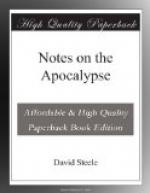Their king is “Abaddon or Apollyon,” the destroyer: for so is his name by interpretation, both in Hebrew and Greek. He is from the “bottomless pit,”—from hell, the vicegerent of the devil. Mahomet in person, and in the person of his official successors, will alone answer to this duplicate symbol. This is, without a rational shadow of ground for controversy, the Great Eastern Antichrist, sufficiently distinguished from the Western. The western combination against real Christianity never attained to power by successful conquest of the nations; but on the contrary by chicanery, insidious policy, flattery of princes and priestcraft. This enemy is described with sufficient accuracy and peculiar precision in the subsequent part of the Apocalypse. Prophecy has a determinate meaning; and we are not at liberty to give loose reins to our imagination: otherwise we shall bewilder, rather than satisfy the devout and earnest inquirer.
12. One woe is past: and, behold, there come two woes more hereafter.
V. 12.—Before the time of the sixth trumpet, intimation is given that some pause shall intervene prior to the judgments which are to follow:—“One woe is past.”—The object of the first woe is the nominally Christian Roman empire, which still stands in its Eastern section; and is to be totally demolished by the second woe-trumpet: for the Western section, recovering from the effects of the first four trumpets, is the object of the third and last woe. The “man of Sin,”—the “little horn” of Daniel, is actuating the “ten horns” to “scatter Judah,” etc., during the time of the Mahometan conquests in the East; by which the whole Roman empire is ripening for the harvest of the vials of wrath.
13. And the sixth angel sounded, and I heard a voice from the four horns of the golden altar which is before God,
14. Saying to the sixth angel which had the trumpet, Loose the four angels which are bound in the great river Euphrates.
15. And the four angels were loosed, which were prepared for an hour, and a day, and a month, and a year, for to slay the third part of men.
16. And the number of the army of the horsemen were two hundred thousand thousand; and I heard the number of them.




